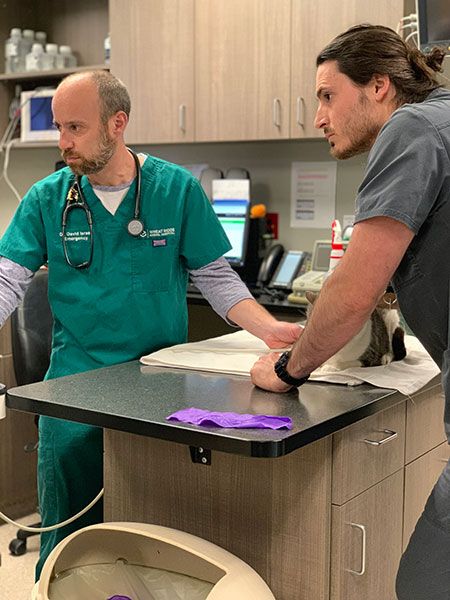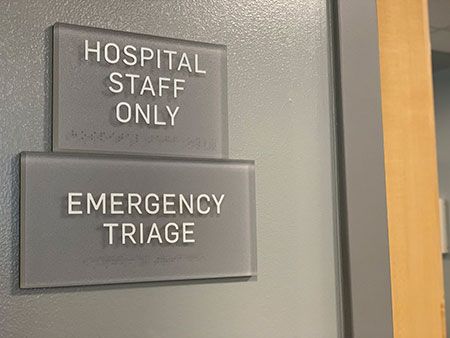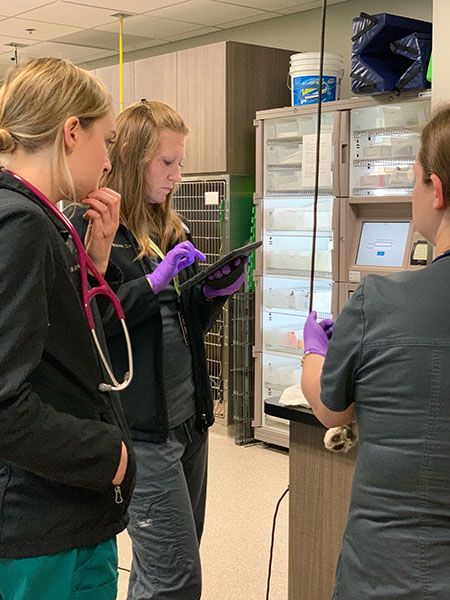Keeping ER clients calm: It takes the entire veterinary team
Pet owners are often frantic when they show up at the emergency veterinary hospital. Helping them know what to expect through all the steps of their visit is a simple way to alleviate worry and stress.

David Israel, DVM (left), one of the emergency veterinarians at Wheat Ridge Animal Hospital in Denver, Colorado, and technician Billy Fagan, CVT, assess a patient. (All photos courtesy of Rebecca Rybak, CVT.)
When you walk into a human emergency room, you know what to expect. You're greeted by someone who asks your presenting complaint. You're triaged by a nurse who records your vitals, does a quick assessment and takes a history, determining whether you can wait or need to be seen immediately. Eventually, you see the doctor who performs the exam, tells you what the major concerns are, and outlines a treatment plan, which may or may not include diagnostics.
There's a lot of waiting. Different departments are involved to collect samples or perform diagnostics. At the end of the visit, after all tests and treatments are done, you're either hospitalized or sent home with prescriptions and instructions on when to follow up with your primary care doctor.
A veterinary emergency room is different in many ways. The biggest difference, in my opinion, is that we don't have different staff members assigned to different types of cases-critical situations, pain or limping, gastrointestinal disturbances and so on. If a critical patient comes in, all support staff members are pulled from their stable cases to assist. The wait can get long while the patient is stabilized.
It's up to everyone involved in the process to help communicate what's going on with the pet owners. Key players in this role? The front desk staff. These team members need to be trained appropriately on which cases should be seen urgently and which can wait for a triage nurse, and they should be encouraged to bring any patients they're concerned about to the back, where a technician or doctor can do a rapid assessment.
This helps on many fronts: The patient is triaged. The owner feels validated and more willing to wait, knowing their pet was assessed by medical staff. The front desk will start to recognize true emergencies. And the medical staff will be able to deal with critical cases knowing that everything in the lobby is fairly stable.
While the front office staff is important, everyone shares in the responsibility of communicating the pet's status with clients as the case unfolds. Let's take a closer look.

The entrance into the triage and treatment area at Wheat Ridge Animal Hospital.
When the client first arrives
When a pet owner walks into the emergency department with their beloved pet, they should be greeted immediately by someone at the front desk and asked what brought them in. They should then be told one of two things:
If the patient is stable: “I can go ahead and get you checked in. I'll have you both wait in our waiting area until a technician is available to take you to an exam room and get further history. Right now, the approximate wait time is 30 minutes [always give your staff extra wiggle room]. If you need anything while you're waiting, please don't hesitate to come speak to any of us.”
If the patient is not stable: “I'm concerned about Buddy [mention the patient's labored breathing, pale mucous membranes, or whatever it is that's of concern]. I'm going to borrow your pet to have my medical staff take a look at him. Are you OK with them starting treatment if needed? We'll keep you updated, and a member of the medical team will be out to get further history as well as discuss any additional steps. Please let us know if you need anything while you're waiting.”
Note: If you leave the patient in the treatment area, make sure to update the owners when you come back out. It's unnerving for them to see you take their pet and then return without it.

Elaine Schey, CVT (center), and emergency doctor Erin McCarragher, DVM (left), discuss a few critical cases at Wheat Ridge Animal Hospital. The team uses iPads and computers to take notes and record vitals, which allows doctors and technicians to access the file from any computer in the hospital.
In the exam room
Once the client is taken to an exam room, it becomes the responsibility of the medical staff to inform them of next steps. After getting a brief history and vitals, the technician should advise the pet owner that they're going to discuss the case with the doctor (who will be in shortly) and provide an approximate wait time. If a critical case comes in, pet owners greatly appreciate someone popping in and saying, “Unfortunately, we've had a critical patient come in. The doctor is stabilizing it and will be with you shortly. Thank you for your patience.”
Once the veterinarian is able to assess a stable patient in the exam room, that doctor can recommend next steps for diagnostics and treatment. Either the doctor or technician should keep the owner informed every step of the way. It's ideal to have a technician assigned to each case to minimize risk of miscommunication.
Getting ready to leave the hospital
At the time of discharge, the owner should be provided with clear-cut written instructions regarding medications, food recommendations, exercise restrictions, follow-up treatments and rechecks at the regular veterinarian. Written instructions are crucial, as most pet owners are overwhelmed by the amount of information they've been given and have little to no medical knowledge.
The technician or doctor should also discuss medications in depth with the client. Pet owners appreciate helpful hints like how to hide bitter pills in a treat or adding low-sodium chicken broth to a bland diet for better palatability. The technician should then either walk the pet owner to the front desk or, at minimum, direct them where to check out and explain when they can expect a follow-up call (if your hospital provides that service).
Checking out
The front desk staff should ask how the visit went and ensure the client received medications and discharge instructions before discussing the bill. If you have a 24-hour courtesy recheck policy, the technician and the front desk should both encourage the owner to bring their pet back if they're concerned, or at least call. The majority of owners will not need to utilize this, but knowing those options are available is very reassuring.
We've all spent years learning how to help our patients, and it's important to alleviate stress, when possible, for our clients as well. Emergencies are never planned, usually stressful and often quite expensive. It's our job as veterinary professionals to keep our clients informed of what to expect as well as how things are going. This will help put their minds at ease and allow greater understanding.
The better a pet owner understands the situation, the more compliant they will be. The more compliant an owner is, the better the pet's chances of recovering. And when a pet recovers well, this is the best outcome for patients, pet owners and the veterinary hospital.
Rebecca Rybak, CVT, is a triage and treatment technician at Wheat Ridge Animal Hospital in Denver, Colorado.